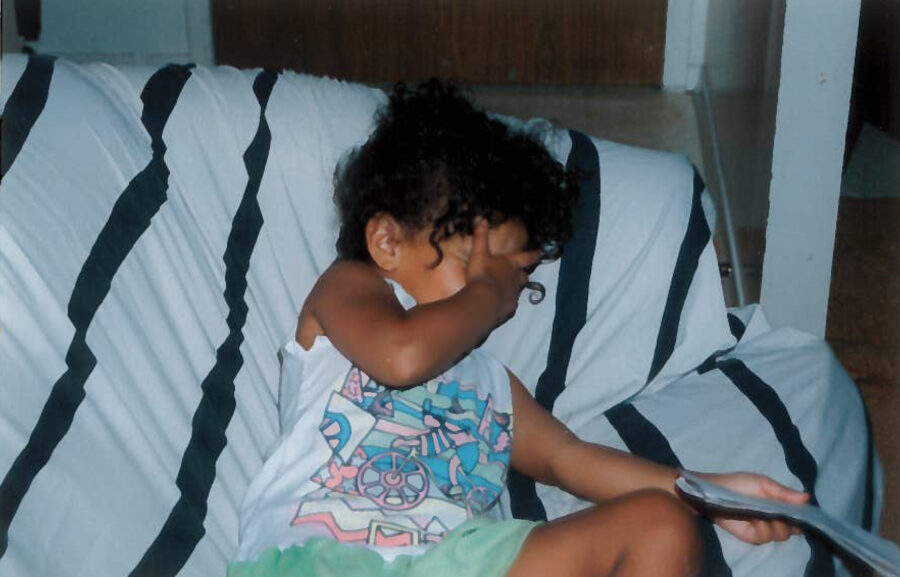
Photo of the writer in the era of fortress building
Unpacking
By Shimby
There was a time when intersecting shared identities were all I longed for. I wanted to make sense of and connect my burgeoning experiences with young adulthood, diaspora, gender, sexuality and art. I sought role models to emulate who embodied parts of me that were starting to splinter into separate categories. I searched for hours online looking for artists whose work resonated and shared some sort of resemblance. Web quests led me to the film work of Salem Mekuria and Lucy Gebre-Egziabher, the photography of Aida Muluneh and the print work of Julie Mehretu. Their work was visceral and their practices satiated some of that longing.
My mother went to the School of Art at the University of Manitoba throughout my childhood. I have memories of building small fortresses out of chairs and blankets in the dining-room-turned-studio, casually bearing witness to her brilliance. But I craved more. I searched beyond her practice of ceramics and painting and beyond her experiences. There was room for that in our relationship. I wanted other women to emulate—artists who were established in the mediums I was interested in. I wanted to find printmakers, filmmakers and photographers who resembled me because there was a tangible absence. I needed to find artists who could pacify my budding otherness and offer glimpses of what my arts practice could look like.
I’ve looked for connections through shared identities for a long time, but I don’t think shared identities are enough anymore. Rather, a spark is what’s actually desired. Some kind of connection. A subconscious, mutual understanding. Recognition. Trust. Community is always shifting and the changing nature of it in my life can leave me weary. At the same time community can offer access points to these magical moments of creative radiance and comfort.
I met Aida Muluneh who mentored me for a beautiful year. I met Salem Mekuria, too, while working at a women-run gallery in Addis Ababa, Ethiopia where a triptych of hers was installed. I saw Julie Mehretu’s larger-than-life print works at the MoCA in LA and followed her elusive practice for years, but no contact was ever made. Lucy Gebre-Egziabher and I are emailing back and forth, negotiating future conversations. And then there’s Sephora Woldu, someone who isn’t a generation apart and is making film. Her practice is synonymously poignant and playful.
I look to these artists for inspiration and guidance. I know not to pedestalize them or draw nonexistent connections with their practices. I understand their work beyond their identities but at the same time, having multiple shared identities with other artists is important to me, still. Especially when they’ve made such broad and differing bodies of work. They are dissimilar, uninfluenced by each other. This dissimilarity—this broad and wide-ranging set of practices—is what influences me. There’s a lack of uniformity between them because the category they all fall under is just a social construct.
I’m supposed to be writing about this construct: diasporic Ethiopian/Eritrean women experimental filmmakers. But I can’t help but feel that if I unpack all of these categories for you, there will be a level of access that you as the reader will gain that I won’t have control over. Do you deserve my hand to hold, guiding you through these realities that aren’t your own? I carry these identities, so of course I can write about them. But why? For who? You? (See Gurpreet Sehra’s Native Informant and the Diaspora in MAWA’s spring 2013 newsletter.)
How does our role as artists shift when we have identities in common? Maybe we’re meant to build community or maybe not. What if we meet and we don’t like each other for some reason or another? Are we really peers across the globe and generations apart? At the same time, I need these artists and the work they’ve done. How will we go about negotiating our roles? As artist and audience? I guess I don’t really know. There was a time when intersecting shared identities were all I longed for and sought to emulate . . . Then I learned that sometimes that isn’t enough and maybe mirroring someone else isn’t what I’m after anyways.
Shimby’s arts practice is experimental, diasporic and meditative. She wants to create spaces for deep and shallow connections and her arts practice is about dealing with the realities of that questing. Special thanks to Aikaterini Zegeye-Gebrehiwot, Hana Worku, hannah_g, Shawna Dempsey and Eva-Queen for encouragement and editing. Special thanks to all of the aforementioned artists for unending inspiration.
